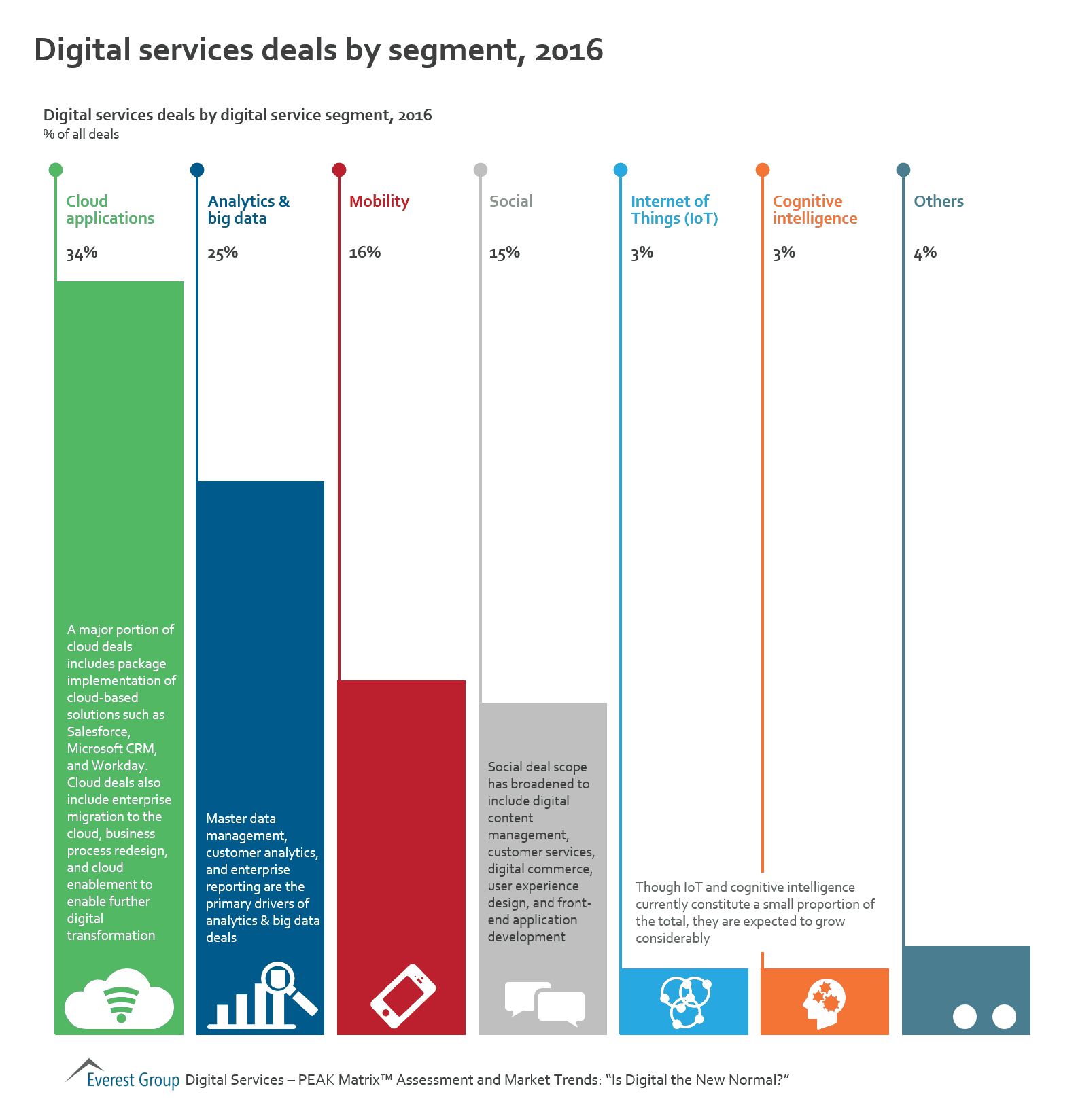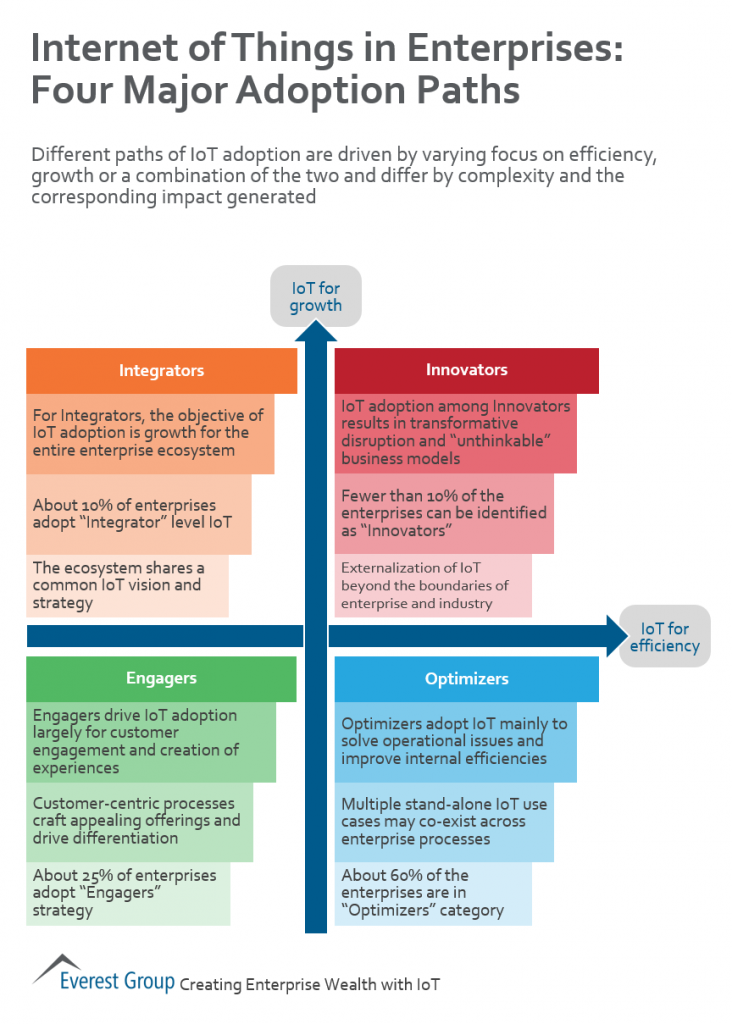
Digital services deals by segment, 2016

Different paths of IoT adoption are driven by varying focus on efficiency, growth or a combination of the two and differ by complexity and the corresponding impact generated
The technology vendor landscape of IoT edge analytics is heating up, with providers such as Cisco and IBM collaborating in an edge partnership, GE Digital’s Predix augmenting its edge capabilities, HPE boosting the capabilities of its Vertica portfolio, and PTC adding muscle to ThingWorx.
They and all the leading IoT analytics vendors, including AWS IoT, Microsoft IoT Suite for Azure, and SAP HANA Cloud IoT Service, are adding or enhancing their edge analytics capabilities, as there is a growing realization that cloud-centered analytics may not be able to deliver the necessary run time “action” expected of the IoT.
At the same time, the market realizes that edge analytics does not add meaningful value in terms of detailed insights into a system, and is generally suitable for small-sized projects. Moreover, many enterprises believe that though edge analytics reduces the entry barrier to the IoT, it does not provide meaningful value if not enhanced with a cloud-based data crunching system.
Enterprises that deal with a very large set of IoT data will normally have requirements for both real-time analytics and detailed insights. Thus, they may consider splitting their analytics lifecycle into two parts, running analytics models on the edge and performing detailed IoT analytics and model development in a cloud. However, this is easier said than done, and will require creative thinking from the architects, application developers, and device makers. It will also require enterprises to have different efficacy models for edge analytics and cloud-based analytics. For edge analytics, it’s about driving real time decisions or device-specific analysis, while cloud-based analytics is most suitable for fundamentally enhancing the IoT value chain.
IoT architects understand the underlying limitations they will face to run analytics on edge devices (e.g., memory, capacity, and power consumption), yet they are being pushed by the business to be as close to the data as possible. Smart architects will quickly realize that crunching data at the edge can be counterproductive, expensive, and many times just impossible. They can smartly address business requirements by delivering a “centralized + edge” analytics scenario. They should also segregate analytics operations and execution, and creatively deploy these at the edge or in the cloud as needed.
However, with all this confusion running amok, enterprises are finding the IoT landscape technologically overwhelming. Everest Group’s digital research suggests that though ~50 percent of global enterprises have piloted some type of IoT projects, less than 20 percent consider IoT to be in their top three investment priorities. The key reason is that enterprises are unable to accept that they are ready for the IoT, and thus continue to be fence sitters. While there are headline-grabbing case studies, especially in the industrial IoT space, most enterprises are still figuring out the IoT jigsaw puzzle.
Technology vendors, system integrators, and other market participants need to play a constructive role in shaping the IoT, a once-in-a-generation opportunity, into reality. It will be a great pity if they continue to focus on a short-term agenda of selling new technologies to enterprises, rather than meaningfully helping them deploy IoT solutions in their business.
Enterprises will have to be cautious in creating the most suitable IoT architecture for each project. Beyond the technical feasibility, they will be well-served by understanding the vast landscape of IoT technology, and getting a good grasp on the leading IoT technology vendors’ offerings.
I recently met with a major player in the Internet of Things (IoT) space, and the company is incredibly frustrated with how developments are evolving. They pointed out the promise of the IoT but said it’s not evolving much beyond the use case of predictive maintenance. It seems people are In Denial (ID). Why aren’t use cases and revenue opportunities in the IoT exploding? I believe the hindrance is the same as it is when trying to drive change through any new technology: the change is cross-functional.
The fact that it’s not evolving much beyond predictive maintenance types of use cases is frustrating to any CIO looking for the next big thing in technology-enabled competitive advantages.
Big data analytics, Service provider convergence, Internet of Things, Productization, Machine learning and automation
Click image to enlarge
The Internet of Things and Big Data Analytics Go Hand-in-Hand
European digital technology adoption maturity curve
Insurance AO buyers’ emerging priorities and key investment themes
It’s the middle of the week and despite all the caffeine-induced stimulation I am in a cynically contemplative mood.
Reason? The past 6 weeks have been spent attending analyst events and conferences, listening and debating with business leaders and thought leaders on what will make the global services industry click. There has been a flood of “paradigm-changing” buzzwords, new solutions on the horizon, and yes, the predictions that claim to change the world in the next 24-36 months. I’ll not go into the details but if you have managed to find your way to this blog, you probably have already heard these terms – Innovation, Robotics, Automation, Digital, and Internet of Things! (And are probably thinking – “here goes another blog on digital transformation. Yawn!”)
That “yawn” is a symptom of the problems facing the technology industry. Gone are the days when you would look at a new product or an interface and say – “Wow!” I think the last time I exclaimed wow was more than a decade ago when I first saw a GPS map and the smooth voiceover guiding me to my destination. Since then there indeed have been some “Aha” moments but nothing that made me fall off my chair. The reason probably is this – most of our attention has been on innovation rather than invention.
Frankly, all the innovation that we talk about today is a mishmash of just three inventions – computing, internet, and devices. Robotics – check. Automation – check. Digital – check. Internet of things – check! True, we are working on miniaturizing, increasing processing speed, writing hugely complex analytics code, and building beautiful interfaces. Reality check – we are still just exploring the “art of the possible” with the Legos.
What is wrong with that? Absolutely nothing. Incremental invention (or innovation) is a great thing. My issue is with paradigms that are dime a dozen these days. Here is the problem – We are in the age of the “moolah.” Theoretical or conceptual innovation has lesser weight since anything that is not investor-funded and cannot be in hands 18 months down the line, is meh. And that is why the less than smart pursuit to reset and invent terminologies instead of true touch and feel invention. Due to lack of true innovation, buzzwords and bubbles are what keep investors excited and money mobile. And these buzzwords are finally leading to madness.
Each industry event I went to saw analysts and leaders beating each other up with their own definitions of what “Digital” meant – for some it was “business transformation using digital,” for some it was “SMAC,” for some it was “driving growth and efficiency using digital,” while some lazy ones were resigned to “anything that is not analog”! Frankly, this debate made me cringe. It is only when industries lack true innovation that they resort to chest thumping using buzzwords. Global automotive industry is a case in point. Till Elon Musk came along, it was all about lines and curves, three-year warranties, and miles per gallon.
Hence, while I take another sip of my café Americano, I hope a maverick comes along and says, it’s time for telepathic computing, time travel, and an invisibility cloak. Gulp!
The irresistible force paradox asks, “What happens when an unstoppable force meets an immovable object?” I think it’s the opposite when it comes to the Internet of Things (IoT) and the already booming as-a-service economy: “What happens when an unstoppable force befriends an unstoppable object?”
Most of the discussion to date around the as-a-service economy has been focused on cloud services, SaaS, and the likes of Uber. At the heart of this economy are the fundamental premises that customers – either business or consumer – can “rent” rather than own the product or service, and can do so, on demand, when they need it, paying as they go.
Although wishing for the utopian as-a-service model may be a futile exercise, the IoT can initiate meaningful models for heavy investment industries and quite a few consumer-focused businesses, and as technologists we should continue to push the envelope.
Let’s step back and think about how the IoT can push the sharing economy to its potential. Can product manufacturers leverage IoT principles, and create a viable technical and commercial model where idle assets are not priced, or are priced at a lower rate, thus saving customers millions of dollars? This would, of course, require collaboration between customers and product manufacturers to enable insight into how, when, and how much a customer consumes the product. But consider the possibilities!
One example is the car-for-hire market. Could a customer’s wearable device communicate with a reserved car, notifying it of approximate wait time until it’s required, enabling the vehicle to be productively deployed somewhere else, in turn enabling the business to offer lower prices to the customer and reduce the driver’s idle time? I think the technology is there, and although the task is humongous and with uncertain returns, I am sure someone, (ZipCar?) will experiment with this model at scale in the near future.
Another example is the thousands of small healthcare labs that cannot afford to own a blood analyzer. Innovative manufacturers of these machines could leverage IoT principles to analyze the blood test patterns of individual labs, and offer them a subscription model by which they are charged per blood test executed, or offered a bundled price of $X per 100 blood tests (much like HP’s Instant Ink offering.)
The IoT has the potential to really bring upon us the power of a sharing economy. In the near-term, businesses face challenges in developing a viable commercial and support model. However, they must overcome this in order for society at-large to truly benefit from this once-in-a-lifetime opportunity. They must remember that most industry disruption these days comes from outside the industry. If they don’t cannibalize themselves, someone else will. Thus, as the traditional competitive strategy levers are fast losing relevance, the IoT most definitely should be an integral part of their strategy.
Photo credit: Flickr

©2023 Everest Global, Inc. Privacy Notice Terms of Use Do Not Sell My Information
"*" indicates required fields